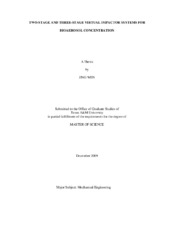| dc.description.abstract | The Circumferential Slot Virtual Impactor (CSVI) and The XMX/2A are two virtual impactors designed for sampling aerosol particles from a dilute environment by separating the aerosol into a fine and a coarse particle fraction. Dust particles in the ambient air may deposit within the virtual impactors and affect their performances. In this study the effect of dust loading within the CSVI on the efficiency of transmission was determined for particles from 0.49 to 9.9 mm in aerodynamic diameter (AD), and the performance of the three stage XMX/2A aerosol concentrator was characterized with 1 mm-9.9 ?m AD polystyrene latex microspheres (PSL).
In the first experimental configuration, the two-stage CSVI had a first stage inflow of 100 L/min and a second stage minor flow of 1 L/min, each stage operating at an inflow/minor flow ratio of 10. An In-line Virtual Impactor (IVI) was used as a pre-separator for sampling inlets to exclude large particles. When the 100 L/min IVI with the two-stage CSVI was tested with Arizona Fine Road Dust (ARD A-2) particles, the transmission efficiency dropped to 50% when the dust entering the two-stage CSVI accumulated to about 100 mg. When it was tested with ASHRAE dust, a decrease of 43% in the efficiency was detected after more than 200mg ASHRAE dust entered the two-stage CSVI. After cleaning the CSVI unit, the transmission efficiency returned to 99%, which indicated that the dust dissemination resulted in the plugging of the CSVI unit. The transmission efficiency of CSVI dropped more quickly below 50% when tested with the ARD A-2 dust, which had smaller particle sizes.
In the second configuration, XMX/2A, a three-stage aerosol concentrator designed to draw 800 L/min of air was used at a measured sampling flow rate of 742 L/min. XMX/2A equipped with an inlet was tested with 1 mm-9.9 mm AD PSL in a testing chamber. The peak transmission efficiency of XMX/2A was 39.5% for 8 mm AD PSL. By using the room air as cooling air and introducing dilution air to the flow cell, the transmission efficiency of each particle size increased.
A combination of monodisperse PSL and oleic acid particles represent the performance of CSVI. In the IVI-CSVI dust test, the CSVI unit SN003 had the best performance when tested with ASHRAE dust. XMX/2A had relatively low transmission efficiency when tested with PSL particles in the chamber. | en |


